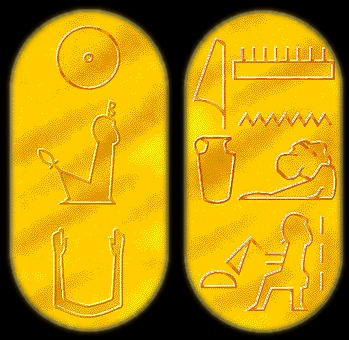
 Make your own cartouche
Make your own cartouche
Courtesy Harcourt Brace Publishers
Hatshepsut's full name, according to an account by Edouard Naville, is composed of four parts. The first, her "standard" name, is "she who is rich, powerful through her 'ka's, her doubles." The second, read as nebti refers to the pharaoh's dominion over both East and West. The third is her "Horus" name, reading "The divine one in her risings". Finally, her name continues with two cartouches, the first reading Kamara, the "true double of Ra". The second cartouche has no holy meaning but instead reads her name given at birth, "Hatshepsut".
Thus her full name, as inscribed on her "great seal",
was
the Horus, mighty by his Kas, the lord of East and West abounding
in years, the good goddess, the pious lady, the golden falcon, divine
in her rings, the King of Upper and Lower Egypt, Kamara, the daughter
of Ra, Khnumit Amon, Hatshepsut."
It is interesting to note the disparity in her sex identity from the beginning of her name to the end. Whether the mistakes of scribes and artists, or difficulties in Egyptian written language, or simply the inability of Egyptians to reconcile the words "female" and "pharaoh" as referring to the same person, the representation of Hatshepsut as both female and male in hieroglyphs and statuary appears in work done throughout her reign.
Naville believed there was more reasoning used to determine the sex of representations of Hatshepsut. He believes she was perfectly content being sculpted as a woman while she was queen, but as soon as she took the throne, she took a man's image in her statuary. Because so few would understand the written word, she was not as adamant taking the male gender in written accounts of her reign.
This site was created and is maintained by David Bediz.